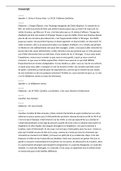Summary
Development economics - Summary - Tilburg university - Economics
- Course
- Institution
Instagram: ECOsummaries DM me for 20% discount! Summary for the course ''Development economics''. This summary was written in order to study for the final. Everything you need to know is available in this summary. Advice: this summary alone will not be enough, the tutorials are as important and ...
[Show more]




